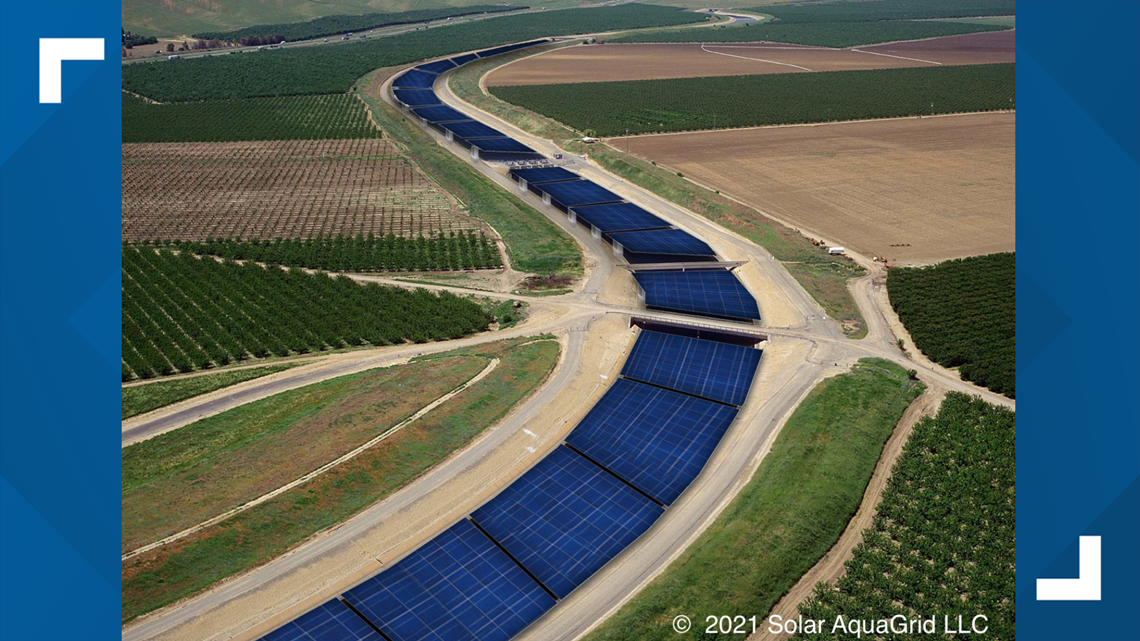TURLOCK, Calif. — For Roger Bales, the future of California could be an iconic one with renewable energy.
In that vision of the future, he sees trips from Sacramento to Los Angeles in an electric car, where you can stop and charge your car with solar energy that was generated over some of California’s canals.
“I think it’s really cool… I think it can help people say ‘yes, this is the direction we need to be going. We need to have built smart infrastructure,’” Bales said. “So, I think it can have a snowball effect for public education and public appreciation for where we can be headed in terms of a sustainable future for children.”
The key element to that vision is solar panels over California’s 4,000 miles of canal systems. It’s not necessarily a new idea, but Bales is one of a few people behind some new research on the topic. Specifically, his team poured themselves into a study to figure out whether it would even make sense to do something like that, and to Bales, the answer is a “yes,” economically speaking.
The study said covering California’s canals with solar panels could translate in up to 63 billion gallons in water savings, 13 gigawatts of solar energy, and even some maintenance savings.
For perspective, Bales said 13 gigawatts of production capacity is about 1/6 of the state’s total electricity generation and that 63 billion gallons of water is enough to irrigate 50,000 acres of land or support millions of people.
“The 193,000-acre feet (63 billion gallons) could also serve a city of 2 million people, so larger than the Sacramento municipal area,” Bales said.
In some senses, it’s a natural harmony between electrical infrastructure and water infrastructure. Solar panels block sunlight from hitting the water, reducing evaporation, and the water cools the solar panels, making them more efficient at generating electricity.
Another added bonus is that the energy production would be done over currently disturbed land, meaning there’s no need to convert farmland or natural lands for energy production.
“We need to think laterally. We need to think creatively about how to build our infrastructure in a smart way. Putting electrical infrastructure together with water infrastructure, that makes a lot of sense,” Bales said.
Turlock Irrigation District (TID), water and power provider for about 100,000 customers, seems inclined to agree, but they’d like to do some more research before putting any solar panels over their canals.
“It’s something that we’ve heard about or thought about in concept before, but the study and actually seeing the results brought it back into our attention. And, it’s something we’re definitely interested in looking at further,” said Josh Weimer, external affairs manager at TID.
TID is currently evaluating locations for a solar project in the district, so the study was a pretty timely arrival and the idea of using their existing infrastructure is being brought into the conversation. While the study shares a lot of wins in taking on such an effort, Weimer said there’s still some more to learn.
“It does seem like a win-win, but there’s definitely some things we want to look into a little bit further,” Weimer said. “Obviously putting anything around our irrigation infrastructure, we just want to make sure we’re not limiting our ability to maintain and properly secure our canals, but there is potential…”
The district is eyeing concepts and designs for their 250 miles of canals and figuring out where those concepts might work. It’s expected to reach its board of directors by the end of the year.
Bales added that, following the UC Merced’s study, a site-specific study and demonstrations would be the next step. The evaporation savings are based on solar panel-covered canals in India.
“Talking to some people that are designing the next generation of solar that can cover canals, they say they think they can achieve much higher (savings), but we need a demonstration project to really evaluate that because theirs is a hypothesis and we need real data,” he said.
Modesto Irrigation District appears to be one of the districts in that camp.
“MID continues to be an innovative leader in water management and a proponent of renewable energy in a practical and financially prudent manner,” Samantha Wookey, MID spokesperson, said in a statement to ABC10. “The real-world application of UC Merced’s work is largely unknown and we look forward to carefully analyzing the results of possible application at a large scale in California.”
The potential water savings and solar energy generation come at a time when California is staring down drought concerns and a changing climate.
Christopher Hyun, a climate scientist with the State Water Board, said climate change is increasing drought frequency and severity, reducing snowpack, and drying soils, which make the state’s water supplies more vulnerable. He added that temperatures in California are projected to rise significantly in the state's interior regions, where the canal network is.
Bales said covering all of California’s canals could also translate to substantial water savings on the local levels as areas deal with both wet and dry years down the line.
“We need resiliency to get through the dry years and then we have to make the most of the water that comes in the wet years, so increasing our base water supply in all years can be really important,” he said.





